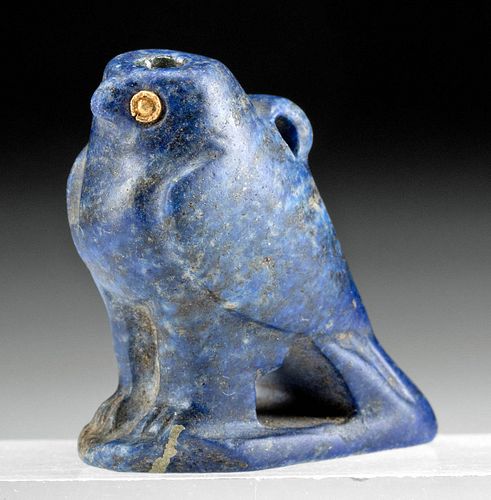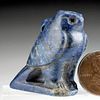Egyptian Lapis Lazuli Falcon w/ Inlaid Gold Eye
Lot 16
About Seller
Artemis Fine Arts
686 S Taylor Ave, Ste 106
Louisville, CO 80027
United States
Selling antiquities, ancient and ethnographic art online since 1993, Artemis Gallery specializes in Classical Antiquities (Egyptian, Greek, Roman, Near Eastern), Asian, Pre-Columbian, African / Tribal / Oceanographic art. Our extensive inventory includes pottery, stone, metal, wood, glass and textil...Read more
Estimate:
$9,000 - $14,000
Absentee vs Live bid
Two ways to bid:
- Leave a max absentee bid and the platform will bid on your behalf up to your maximum bid during the live auction.
- Bid live during the auction and your bids will be submitted real-time to the auctioneer.
Bid Increments
| Price | Bid Increment |
|---|---|
| $0 | $25 |
| $300 | $50 |
| $1,000 | $100 |
| $2,000 | $250 |
| $5,000 | $500 |
| $10,000 | $1,000 |
| $20,000 | $2,500 |
| $50,000 | $5,000 |
| $100,000 | $10,000 |
| $200,000 | $20,000 |
About Auction
By Artemis Fine Arts
Mar 24, 2022
Set Reminder
2022-03-24 10:00:00
2022-03-24 10:00:00
America/New_York
Bidsquare
Bidsquare : Exceptional Antiquities Ethnographic Fine Art
https://www.bidsquare.com/auctions/artemis-gallery/exceptional-antiquities-ethnographic-fine-art-9057
Museum-worthy examples of classical antiquities (Egyptian, Greek, Roman, Near Eastern), Viking, Far East / Asian, Pre-Columbian, African / Tribal, Oceanic, Native American, Spanish Colonial, Fossils, Ancient Jewelry, Fine / Visual Arts, so much more! Artemis Fine Arts info@artemisgallery.com
Museum-worthy examples of classical antiquities (Egyptian, Greek, Roman, Near Eastern), Viking, Far East / Asian, Pre-Columbian, African / Tribal, Oceanic, Native American, Spanish Colonial, Fossils, Ancient Jewelry, Fine / Visual Arts, so much more! Artemis Fine Arts info@artemisgallery.com
- Lot Description
Egypt, Late Dynastic Period, 26th to 31st Dynasty, ca. 664 to 332 BCE. A gorgeous falcon figure of petite size and exquisite form that is hand-carved from mottled, azure blue lapis lazuli with dark brown, burnt ochre, and khaki hued inclusions. The majestic raptor stands upright with attenuated legs atop an integral rectangular plinth and presents its rounded chest that hangs slightly over the plinth's edge. Both teardrop-shaped wings are laid atop its back with the tips folded atop the tab-shaped tail, and an integral suspension loop is situated just beneath the neck on the verso. The squat head features a nubbin aquiline beak, a cavity atop the head that held an attached headdress at one time, perhaps the Pschent crown, and a pair of deep orbitals with a 68.25% gold eye inlaid within the proper left cavity. With smooth surfaces and deep coloration, this is a wonderful example of ancient Egyptian lapidary sophistication! Size: 1.35" L x 0.67" W x 1.34" H (3.4 cm x 1.7 cm x 3.4 cm); gold quality: 68.25% (equivalent to 15K+)
The falcon was traditionally associated with several Egyptian deities. In addition, the falcon was a symbol of the sky-god Horus as well as the sun-god Amun-Ra and the war-god Montu, who was also a solar deity. According to Egyptologist Dorothea Arnold, "The ancient Egyptians believed their kind was an incarnation of the sky god, Horus, who appeared as a falcon." She also writes how, "In their representations of Horus Egyptian artists depicted a generalized falcon, rather than any one particular species, even though Egypt is home to several. The Lanner falcon, Falco Biarmicus, and the peregrine, F. peregrinus, for example, still nest and breed in the limestone cliffs at the desert margin and in the ruins and pyramids. The birds can be seen rising on updrafts of hot desert air and performing amazing acrobatics. Th[is] sculpture follows the Late Period tradition of animal images in hardstone . . . with remarkably naturalistic details in the head and feet, while the body and wings are simplified renderings of the bird's natural features." (Arnold, Dorothea. "An Egyptian Bestiary." The Metropolitan Museum of Art Bulletin, Spring 1995, Vol. LII, no. 4, p. 45)
Cf. The Metropolitan Museum of Art, accession number 26.7.895 and The Walters Art Museum, accession number 42.220
Provenance: private Southern California, USA collection, bestowed 2006; ex-private Los Angeles, California, USA collection, acquired before 2006; ex-Hesperia Auction, New York, USA, November 27, 1990, Lot 60 #50
All items legal to buy/sell under U.S. Statute covering cultural patrimony Code 2600, CHAPTER 14, and are guaranteed to be as described or your money back.
A Certificate of Authenticity will accompany all winning bids.
PLEASE NOTE: Due to recent increases of shipments being seized by Australian & German customs (even for items with pre-UNESCO provenance), we will no longer ship most antiquities and ancient Chinese art to Australia & Germany. For categories of items that are acceptable to ship to Australia or Germany, please contact us directly or work with your local customs brokerage firm.
Display stands not described as included/custom in the item description are for photography purposes only and will not be included with the item upon shipping.
#170611Losses to proper right gold eye and headdress atop head as shown, with old mounting adhesive residue within cavity atop head. Chip to front left corner of plinth, with light abrasions and softening to some finer details, and small nicks, indentations, and encrustations to remaining gold eye. Great surface smoothness and preservation to overall form.Condition
- Shipping Info
-
All shipping is handled in-house for your convenience. Your invoice from Artemis Gallery will include shipping calculation instructions. If in doubt, please inquire BEFORE bidding for estimated shipping costs for individual items.
-
- Buyer's Premium



 EUR
EUR CAD
CAD AUD
AUD GBP
GBP MXN
MXN HKD
HKD CNY
CNY MYR
MYR SEK
SEK SGD
SGD CHF
CHF THB
THB














